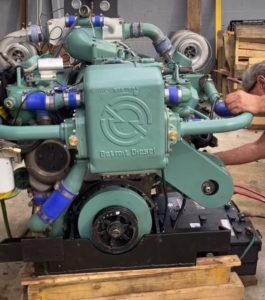Proper storage and preservation of Detroit Diesel 92 Series engines ensure their longevity and readiness for operation after extended periods of inactivity. Whether preparing for long-term storage or restoring the engine for use, following the correct procedures is essential to avoid damage, corrosion, or degraded performance. Below is a detailed guide to preparing and restoring these engines.
Preparing the Engine for Long-Term Storage

-
Perform Initial Maintenance
- Conduct a thorough inspection and perform all scheduled maintenance tasks, including:
- Changing the engine oil and filter to remove contaminants.
- Draining and replacing coolant with a 50/50 mixture of antifreeze and distilled water.
- Replacing air and fuel filters to ensure no contaminants remain in the system.
- Conduct a thorough inspection and perform all scheduled maintenance tasks, including:
-
Clean the Engine
- Clean the exterior of the engine to remove dirt, grease, and debris.
- Use a degreaser on heavily soiled areas and rinse with water. Ensure the engine is completely dry before proceeding.
-
Preserve the Fuel System
- Add a fuel stabilizer to the fuel tank to prevent degradation.
- Run the engine briefly to circulate the treated fuel through the system.
- Drain the fuel-water separator to remove accumulated water and sediment.
- Protect the Cooling System
- Ensure the cooling system is filled with corrosion-inhibiting coolant.
- For marine engines, flush the raw water system with freshwater and drain to remove salt and debris.
Raw Water Cooling Components For Detroit Diesel 6V92 Non Turbo
Raw Water Cooling Components For Detroit Diesel 6V92 Turbo
Raw Water Cooling Components For Detroit Diesel 8V92 Non Turbo
Raw Water Cooling Components For Detroit Diesel 8V92 Turbo
Raw Water Cooling Components For Detroit Diesel 12V92 Non Turbo
Raw Water Cooling Components For Detroit Diesel 12V92 Turbo
Raw Water Cooling Components For Detroit Diesel 16V92 Non Turbo
-
Preserve the Cylinders
- Remove the injectors or spark plugs (for gas systems, if applicable).
- Spray a corrosion-inhibiting oil into each cylinder to coat the interior surfaces.
- Rotate the crankshaft manually to distribute the oil evenly.
-
Seal Openings
-
Seal all engine openings, including the intake, exhaust, and crankcase breather, using moisture-resistant caps or tape.
- This prevents the entry of dirt, moisture, or pests during storage.
-
-
Disconnect the Battery
- Disconnect and remove the battery to prevent corrosion or accidental starts.
- Store the battery in a cool, dry place and periodically recharge it to maintain its capacity.
-
Store the Engine in a Controlled Environment
-
Place the engine in a clean, dry area with minimal temperature fluctuations.
- Use a vapor corrosion inhibitor (VCI) bag or tarp to cover the engine, providing additional protection against moisture.
-
Restoring an Engine from Storage

-
Perform a Visual Inspection
- Remove all coverings and inspect the engine for signs of damage, corrosion, or pest intrusion.
- Check hoses, belts, and seals for cracks, wear, or brittleness.
-
Drain and Replace Fluids
- Drain the old oil and replace it with fresh oil to ensure proper lubrication.
- Drain and refill the cooling system with a new 50/50 antifreeze mixture.
- Inspect the fuel system and replace the fuel filters before adding fresh, treated fuel.
- Inspect and Reinstall Components
- Inspect injectors and reinstall them after cleaning or replacing as needed.
- Check the air filter for blockages or damage, replacing it if necessary.
- Verify that the exhaust system is clear of obstructions.
-
Reconnect the Battery
- Clean the battery terminals and reconnect the battery to the engine.
- Check the battery’s charge level and recharge if necessary.
-
Prime the Fuel System
- Prime the fuel system to remove air and ensure proper fuel delivery. Use the manual priming pump or run the automatic priming cycle if equipped.
- Prime the fuel system to remove air and ensure proper fuel delivery. Use the manual priming pump or run the automatic priming cycle if equipped.
-
Rotate the Crankshaft
- Manually rotate the crankshaft several times to ensure the engine components move freely and to distribute oil within the system.
- Manually rotate the crankshaft several times to ensure the engine components move freely and to distribute oil within the system.
-
Start the Engine
- Start the engine and allow it to idle at low speed (600–800 RPM) for 5–10 minutes to reach operating temperature.
- Monitor gauges for proper oil pressure, coolant temperature, and other critical parameters.
-
Perform a Test Run
- Gradually apply load to the engine while monitoring performance.
- Look for signs of unusual noise, smoke, or vibration, and address any issues promptly.
-
Inspect for Leaks
- After the engine has run for a period, inspect for any oil, coolant, or fuel leaks. Tighten or replace components as needed.
- After the engine has run for a period, inspect for any oil, coolant, or fuel leaks. Tighten or replace components as needed.
Best Practices for Storage and Restoration

-
Documentation
- Keep a record of all storage preparations, including the date, performed tasks, and materials used.
- Document the restoration process, noting any issues and corrective actions taken.
-
Periodic Checks During Storage
- Inspect the engine monthly for signs of moisture, corrosion, or pest activity.
- Rotate the crankshaft periodically to prevent internal parts from seizing.
-
Use Manufacturer-Approved Products
- Always use oils, coolants, and preservatives that meet Detroit Diesel specifications to ensure compatibility and performance.
- Always use oils, coolants, and preservatives that meet Detroit Diesel specifications to ensure compatibility and performance.
-
Restore Gradually
- Avoid overloading the engine immediately after restoration. Allow time for all systems to stabilize before putting the engine into full operation.
- Avoid overloading the engine immediately after restoration. Allow time for all systems to stabilize before putting the engine into full operation.
Conclusion
Proper preparation for long-term storage and thorough restoration procedures are essential for maintaining the reliability and performance of Detroit Diesel 92 Series engines (6V92, 8V92, 12V92, 16V92). By following these guidelines, operators can ensure their engines remain in optimal condition during storage and are ready for seamless operation when needed. Regular checks and careful attention to detail help extend engine life and reduce downtime.



 Free US Calls: 1-888-433-4735
Free US Calls: 1-888-433-4735 International: 305-545-5588
International: 305-545-5588